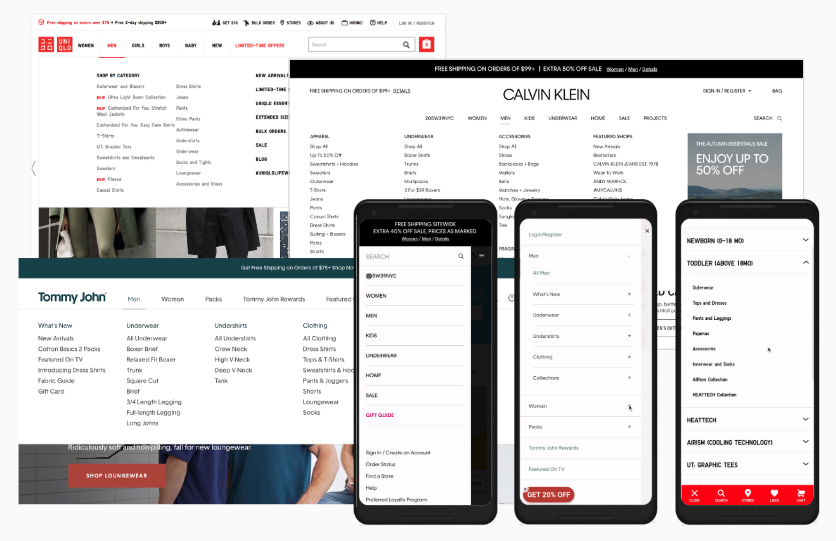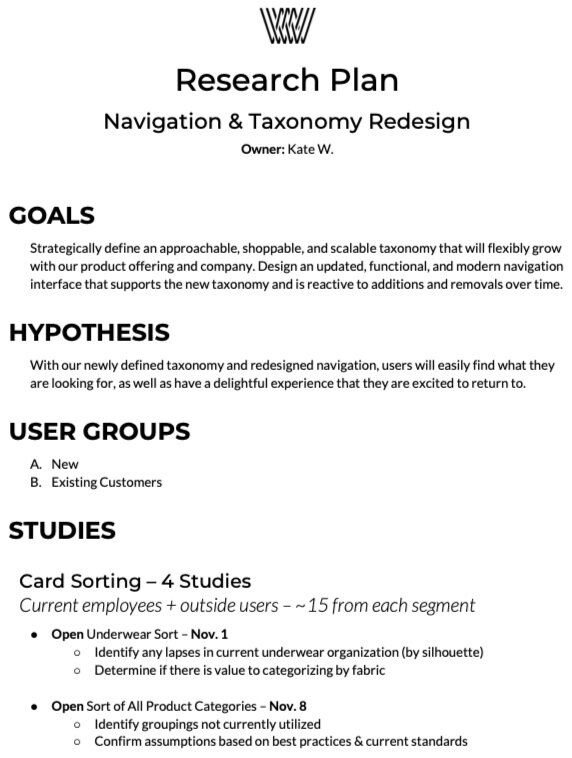Mack Weldon Taxonomy Research
Research; Information Architecture
Our team was at a turning point with our site. We were about to redesign our entire UI and technology, and our taxonomy needed a complete evaluation. Our product offering had grown immensely over the past 6 years, and we wanted a taxonomy that could help support a scalable navigation system that would continue to grow with our organization and catalog.
I strategized, structured, and executed a comprehensive set of research studies to educate our decision-making for the revised taxonomy. Utilizing various methods and user groups, I was able to fully evaluate our users' needs and build out our new guidelines.
The Hypothesis
With our newly defined taxonomy and redesigned navigation, users will easily find what they are looking for, quickly locate new products and best sellers – as well as have a delightful, familiar experience that they are excited to return to.
Project Goals
Create a flexible navigation that can scale with us and our expanding product offering
Modernize and update the functionality and design for ease of shop-ability for users, new & existing
Develop a taxonomy that can evolve and adapt to various seasons, collections, and other arrangements over time
The Process
Research
Gather quantitative and qualitative data from new & existing users to validate our hypothesis and goals.
Prototype
Utilizing research results, create various prototypes to test taxonomy, design, and functionality.
User Testing
Test existing navigation in tandem with new prototypes to educate decisions for final product.
Design & Dev
Finalize designs, development strategy and create a plan for future iterations and growth.
Competitive Audit
Performing a comprehensive competitive audit was integral to seeing what other users were interacting with around the web. I researched various sized companies with multiple types of product offerings. I discovered we sat somewhere between a larger-scale offering, where the primary navigation becomes gendered (shop by 'Men' or 'Women'), and a smaller-scale offering that could be organized into 5 categories or less.
Large Offering Gendered Mega Menu
Smaller Scale Offering
Conclusion
Dropdown mega menu is the industry standard, but can quickly become crowded and obtrusive. With intelligent categorization that flexes with our offering, and a clean visual & interactive design, we can accomplish a menu system that is unique, intuitive, and highly effective.
Research
Current navigation statistics from FullStory
37% of users who arrive at our homepage interact with the navigation
28% interact with nav on the homepage right off the bat
13% of total visitors are clicking a menu item at some point in their session
Top clicked nav items
Boxer briefs, Trunks, Pants, T-shirts
Top clicked categories
Underwear, Tops, Bottoms
Research Studies & User Groups
It was important to us to get perspectives from various user types. These three groups broadly encompass all of our site’s visitors, including employees who are intimate with our offering, so utilizing them in our studies helps us accumulate as much input as possible.
New Users
9 participants
87% completion rate
User Testing
Pattern-finding method to see how users would expect to discover content or functionality.
New users only
Existing Customers
22 participants
51% completion rate
Tree Testing
A technique for evaluating the findability of products in a website’s navigation.
New and existing users
Employees
19 participants
90% completion rate
Card Sorting
Pattern-finding method to see how users would expect to discover content or functionality.
All user groups
User Testing
Purpose
To get candid feedback on our current navigation design and discoverability.
Results
Biggest difficulty was on warm layers, all users easily found long underwear but couldn’t locate the WARMKNIT tops.
Most people easily found swim underwear under swim, but one person got hung up and didn’t notice the “swim” section, and dug through Underwear unable to find something directly targeted to swim.
Most users noticed the Premium Fabrics content block on the homepage, but didn’t know where else to go to discover more about innovative fabrics. One user did end up in actual PDP’s looking at the product descriptions to find out about the fabrics.
Next steps
Validate prototypes and user-test our new navigation.
Card Sorting Results
With various Card Sorting studies, we aimed to narrow down what types of groupings were natural to users, and discover any discrepancies in our current categorization. The following results helped educate our prototypes.
New Users
Underwear
Tops & Bottoms
Casual / Dress Clothes
Socks
Winter Layers
Bags
Accessories
Gift Cards
Existing Customers
Underwear
Socks
Shirts
Bottoms
Outerwear / Warm Layers
Accessories
Gift Cards
Employees
Underwear
Undershirts
Socks
Tops
Bottoms
Outerwear
Accessories
Gift Cards
Interesting Groupings
Everyday / “First Layer”
Underwear, Undershirts & Socks
Outerwear / Cold Weather
Jacket, Hat/Scarf/Gloves, Sweater, Boot Socks, Long Undies
Athletic / Activewear
Tanks, Sweats, Athletic Undies/Shirts/Socks, Swim
Casual Clothes
Shirts, Sweats, Lounge Pants, Casual Socks
Dress Clothes
Pants, Oxford, Chambray, Dress Socks
Tree Test
Purpose
To fact check our taxonomy structure, and to create a seamless way of discovery for all kinds of users by double-exposing, as well as intelligent categorization for intent-driven navigation.
Results
Out of all the tasks completed by participants, 78% ended up at a "correct" answer.
Out of all the tasks completed by participants, 75% of answers were chosen without backtracking.
Amphibious Underwear is still one of the more difficult items to locate, but discoverability will be increased with updated categories.
Warm Layers had people backtracking a bit, probably because WARMKNIT tops and bottoms aren’t grouped together.
Tasks
Find the underwear that is best suited to keep you cool and comfortable while working out.
Find a product you could wear under a bathing suit.
It's getting chilly! Where would you find a product that works as a warm layer to wear under your regular clothes?
You heard an ad on a podcast talking about the innovative fabrics Mack Weldon has created, and are interested in learning more. What product would look at first?
You're expecting to spend a lot of time lounging on the couch this winter. What product would you check out first?
You want to upgrade your underwear. What product would you look at first?
You'll be doing quite a bit of traveling this winter. What product would you check out that could be essential to your adventuring?
You're looking for a cool gift for your brother for Christmas, what do you think would be a good gift?
Research Conclusion
High-level, our existing categorization isn’t totally off. We need to refine and double-expose the appropriate products within a more flexible taxonomy.
Additionally, people are sorting & shopping by use, occasion, and season, so allowing the ability to explore through those channels only helps people find what they’re looking for faster. Adding this type of navigability to the site will encourage more discovery and relevant results.
















